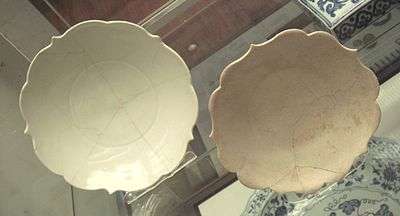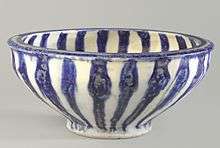Fritware
Fritware, also known as stone-paste, is a type of pottery in which frit (ground glass) is added to clay to reduce its fusion temperature. The mixture may include quartz or other siliceous material. An organic compound such as gum or glue may be added for binding.[1] The resulting mixture can be fired at a lower temperature than clay alone. A glaze is then applied on the surface to harden the object.[1]


Fritware was invented to give a strong white body, which, combined with tin-glazing of the surface, allowed it to approximate the result of Chinese porcelain. True porcelain was not manufactured in the Islamic world until modern times, and most fine Islamic pottery was made of fritware. Frit was also a significant component in some early European porcelains.
History
The manufacture of fritware began in Iraq in the 9th century.[1] Between the 10th and the 12th centuries the main centre of manufacture moved to Egypt, but the technique then spread throughout the Middle-East.[1]
In the 13th century the town of Kashan in Iran was an important centre for the production of fritware.[2] Abū'l-Qāsim, who came from a family of tilemakers in the city, wrote a treatise in 1301 on precious stones that included a chapter on the manufacture of fritware.[3] His recipe specified a fritware body containing a mixture of 10 parts silica to 1 part glass frit and 1 part clay. The frit was prepared by mixing powdered quartz with soda which acted as a flux. The mixture was then heated in a kiln.[4] This type of pottery has also been referred to as "stonepaste" and "faience" among other names.[5] A ninth-century corpus of 'proto-stonepaste' from Baghdad has "relict glass fragments" in its fabric.[6] The glass is alkali-lime-lead-silica and, when the paste was fired or cooled, wollastonite and diopside crystals formed within the glass fragments. The lack of "inclusions of crushed pottery" suggests these fragments did not come from a glaze.[7] The reason for their addition would have been to release alkali into the matrix on firing, which would "accelerate vitrification at a relatively low firing temperature, and thus increase the hardness and density of the [ceramic] body."[7]
Iznik pottery was produced in Ottoman Turkey beginning in the last quarter of 15th century AD.[8] It consists of a body, slip, and glaze, where the body and glaze are 'quartz-frit'.[9] The 'frits' in both cases "are unusual in that they contain lead oxide as well as soda"; the lead oxide would help reduce the thermal expansion coefficient of the ceramic.[10] Microscopic analysis reveals that the material that has been labeled 'frit' is 'interstitial glass' which serves to connect the quartz particles.[11] The glass was added as frit and the interstitial glass formed on firing.
References
- Archaeological chemistry by Zvi Goffer p.254
- Atasoy & Raby 1989, p. 50.
- Allan 1973.
- Allan 1973; Mason & Tite 1994
- Mason & Tite 1994, p. 77.
- Mason & Tite 1994, pp. 79-80.
- Mason & Tite 1994, p. 87.
- Tite 1989.
- Tite 1989, p. 120.
- Tite 1989, p. 129.
- Tite 1989, pp. 120, 123.
Sources
- Allan, J.W. (1973), "Abū'l-Qāsim's treatise on ceramics", Iran, 11: 111–120, JSTOR 4300488, archived from the original on 2012-03-23, retrieved 2011-09-04.
- Atasoy, Nurhan; Raby, Julian (1989), Iznik: The Pottery of Ottoman Turkey, London: Alexandra Press, ISBN 978-1-85669-054-6.
- Mason, R.B.; Tite, M.S. (1994), "The beginnings of Islamic stonepaste technology", Archaeometry, 36: 77–91, doi:10.1111/j.1475-4754.1994.tb01066.x.
- Tite, M.S. (1989), "Iznik pottery: an investigation of the methods of production", Archaeometry, 31 (2): 115–132, doi:10.1111/j.1475-4754.1989.tb01008.x.
Further reading
| Wikimedia Commons has media related to Stone-paste. |
- Mason, Robert B.; Gonnella, Julia (2000). "The petrology of Syrian stonepaste ceramics: the view from Aleppo". Internet Archaeology. 9. doi:10.11141/ia.9.10.
- Tite, M.S.; Wolf, S.; Mason, R.B. (2011). "The technological development of stonepaste ceramics from the Islamic Middle East". Journal of Archaeological Science. 38 (3): 570–580. doi:10.1016/j.jas.2010.10.011..
- History of World Ceramics
- "Technology of Frit Making in Iznik." Okyar F. Euro Ceramics VIII, Part 3. Trans Tech Publications. 2004, p. 2391-2394. Published for The European Ceramic Society.
.jpeg)